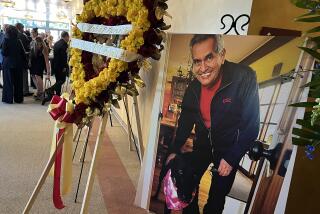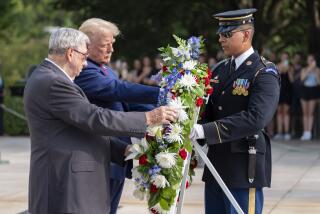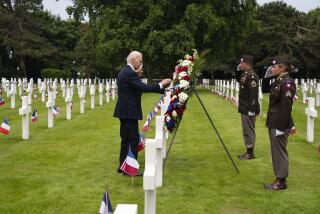Nixon Gets Hero’s Farewell, Is Buried at Boyhood Home : Presidency: Clinton leads current and former officials in mourning. He pays his respects to the late chief executive ‘on behalf of a grateful nation.’
YORBA LINDA — Triumphant at the pinnacle of his political life and scorned in exile, Richard Nixon was given the farewell of an American hero Wednesday and buried at the edge of a rose garden here.
President Clinton, who had worked to deny Nixon a second term, and First Lady Hillary Rodham Clinton, who had joined the legal team that later tried to impeach him, led Republicans and Democrats--officials at the center of power and those, once familiar, who have lived in the political shadows for two decades--in mourning his death.
“On behalf of a grateful nation, we bid farewell to Richard Milhous Nixon,” Clinton said, with the flag-covered coffin and the white clapboard bungalow where the late President had lived until he was 9 years old serving as a backdrop.
“A great man has fallen,” said the Rev. Billy Graham, minister of Presidents, who officiated at the funeral. “The world has lost a great citizen and America has lost a great statesman, and those of us that knew him have lost a great personal friend.”
The 85-minute ceremony in a parking lot covered with green outdoor carpeting closed the circle on one of the most remarkable and complex public lives of the 20th Century, granting to the 37th President of the United States the acceptance, even adulation, he sought so longingly from the Washington Establishment that he, paradoxically, so despised.
For nearly one-quarter of the life of the republic, Nixon was a force who could not be ignored, a galvanizing presence whose image--a ski-slope nose, shoulders hunched awkwardly forward, the loose jowls and the waves of curls thinning into a widow’s peak--inspired a range of gut emotions from unshakable loyalty and deep respect, sometimes induced by fear, to unalloyed loathing.
His funeral, broadcast live across the country, restored to Nixon in death the mantle of the presidency that he had shed on Aug. 9, 1974, when he resigned in the face of certain impeachment in the Watergate scandal.
For nearly 20 years, until he died last Friday of a stroke at the age of 81, he worked assiduously, first to rehabilitate his image and then to assume his place among a pantheon of elder statesmen, with his books on foreign policy and his quiet, private--and, they said, appreciated--advice to his White House successors.
With the funeral staged across the continent from the nation’s capital, which Nixon shunned when funeral plans were made before his death, the trappings of the White House were delivered to him: the flag-draped coffin as well as “Ruffles and Flourishes,” “Hail to the Chief” and a 21-gun salute that boomed across what had been the lemon groves of his youth. Four Air Force jets flew over, in the traditional “missing man” formation.
Minutes later, in a somber graveside ceremony behind the Richard Nixon Library & Birthplace, Graham intoned the 23rd Psalm: “The Lord is my shepherd; I shall not want. . . .” He also recited the Lord’s Prayer.
Two flags that had covered the coffin were neatly folded by the eight military pallbearers and handed to Nixon’s daughters, Tricia Nixon Cox and Julie Nixon Eisenhower, whose composure was breaking as they choked back tears.
Edward Nixon, 63, stood at the graveside as the service concluded, tears streaming down his cheeks, before he walked away from the final resting place of his older brother.
At the end of the day, with most of the guests gone and the sun setting, the mahogany coffin was placed in a grave beside that of Pat Nixon, just a few steps from the house where Nixon was born on Jan. 9, 1913. Mrs. Nixon died last June, 10 months to the day before her husband. A dozen men began filling in the grave, halting their work after five minutes as the Nixon family returned for another visit.
Not since January, 1973, when former President Lyndon B. Johnson died, has the nation witnessed a spectacle like that on Wednesday.
Seated in the front row, on white folding chairs, were Clinton, the 42nd President, and his living predecessors, each of whose lives had intersected with Nixon’s: Gerald R. Ford, who declared to an anxious nation that “our long national nightmare is over,” as Nixon’s resignation took effect, and then pardoned Nixon of any crimes committed during the Watergate scandal; Jimmy Carter, who many believe owed his election to the unpopularity of that pardon; Ronald Reagan, who tried in 1968 to deny Nixon the Republican presidential nomination, and George Bush, who was the Republican Party chairman during the most trying days of Watergate. Each was accompanied by his wife.
Just behind them sat three of those who spoke at the funeral: Henry A. Kissinger, Nixon’s first national security adviser and second secretary of state; Senate Minority Leader Bob Dole (R-Kan.) and California Gov. Pete Wilson.
Behind them were arrayed 4,000 guests, faces familiar yet aged, some still players on the Washington stage, others hoping to return there, indeed to the White House itself. Others had long been in retirement. Among the guests were Spiro T. Agnew, who was Nixon’s first vice president until revelations about past corruption in Maryland forced him to resign; Dan Quayle, the most recent former vice president; entertainer Bob Hope; Alexander M. Haig Jr., Nixon’s last chief of staff and Reagan’s first secretary of state; members of the Nixon Cabinet, and one-fifth of the U.S. Congress.
Faces and names first made familiar from the Watergate years were here: Rosemary Woods, Nixon’s secretary, on whom blame was placed for creating the 18 1/2-minute gap in a tape of a crucial meeting at which the Watergate cover-up was discussed; Howard H. Baker Jr., the ranking Republican member of the Senate Watergate Committee, and G. Gordon Liddy, a key link in the chain between the Nixon White House in 1972 and the men who broke into the Democratic National Committee headquarters at the Watergate complex in Washington. Baker and Liddy rode together on a shuttle bus from a nearby parking lot to the library.
Also there was former Sen. George S. McGovern (D-S.D.). He flew to California aboard Air Force One, a member of the presidential party paying his respects to the man who swamped him in the 1972 presidential race even as the cold winds of Watergate were starting to stir in Washington.
Across an aisle from the presidents, in the front row, were Nixon’s daughters; their husbands, Edward Cox and David Eisenhower, and Nixon’s four grandchildren, Christopher Cox and Melanie, Alexander and Jennie Eisenhower.
Although Nixon was a man who showed little emotion in public, shy and jealous of his privacy, the service prompted unusual displays of emotion--and deeply personal remembrances.
Clinton, who developed a relationship with Nixon only in the last year as he received what he called “his wise counsel, especially with regard to Russia,” offered the briefest and least personal remarks, saying of Nixon:
“He gave of himself with intelligence and energy and devotion to duty, and his entire country owes him a debt of gratitude for that service.”
But it was Clinton who made the most direct, albeit still oblique, reference to Watergate. And it was Clinton who called for an end to judging Nixon through that one prism.
“Oh, yes, he knew great controversy amid defeat as well as victory. He made mistakes and they, like his accomplishments, are part of his life and record,” the 42nd President said. “But the enduring lesson of Richard Nixon is that he never gave up being part of the action and passion of his times.
“Today is a day for his family, his friends and his nation to remember President Nixon’s life in totality. To them let us say, may the day of judging President Nixon on anything less than his entire life and career come to a close. May we heed his call to maintain the will and the wisdom to build on America’s greatest gift, its freedom, to lead a world full of difficulty to the just and lasting peace he dreamed of.”
Remarking on the august assemblage that took part in the funeral, Kissinger said: “Richard Nixon would be so proud that President Clinton and all living former Presidents of the United States are here, symbolizing that his long and sometimes bitter journey had concluded in reconciliation.”
Kissinger, the eminen c e gris e behind the foreign policy that formed the backbone of the Nixon presidency, said that 550,000 Americans were engaged in combat in Vietnam when Nixon took office on Jan. 20, 1969, and that “America had no contact with China, the world’s most populous nation, no negotiations with the Soviet Union, the other nuclear superpower.”
In his deep, rumbling voice, still bearing its trademark German accent, he continued:
“Most Muslim countries had broken diplomatic relations with the United States and Middle East diplomacy was stalemated. All of this in the midst of the most anguishing domestic crisis since the Civil War.
“When Richard Nixon left office, an agreement to end the war in Vietnam had been concluded and the main lines of all subsequent policy were established--permanent dialogue with China; readiness without illusion to ease tension with the Soviet Union; a peace process in the Middle East; the beginning, via the European Security Conference, of establishing human rights as an international issue; weakening the Soviet hold on Eastern Europe.”
It was Kissinger who once described Nixon as “a strong mixture of calculation, deviousness, idealism, tenderness, tawdriness, courage and daring.”
On Wednesday, he said that Nixon was “one of the seminal Presidents” in the conduct of foreign policy. But, he said, “Richard Nixon’s greatest accomplishment was as much moral as it was political: to lead from strength at a moment of apparent weakness, to husband a nation’s resilience and thus to lay the basis for victory in the Cold War.
“So let us now say goodby to our gallant friend. He stood on pinnacles that dissolved into precipice. He achieved greatly and he suffered deeply but he never gave up. Richard Nixon ended a war and he advanced the vision of peace of his Quaker youth. He was devoted to his family. He loved his country. And he considered service his honor. It was a privilege to have been allowed to help him.”
Dole, who began his climb up the ladder of Republican leadership during the Nixon White House years, saluted Nixon’s domestic policy and put Nixon’s roots firmly in the Americana to which candidate Nixon appealed so effectively.
It was Nixon, the senator said, who launched a war on cancer, and “leapfrogged the conventional wisdom and proposed revolutionary solutions to health care and welfare reform, anticipating by a full generation the debates now raging on Capitol Hill.”
“He was the grocer’s son who got ahead by working harder and longer than everyone else. How American,” the senator said. “He was a student who met expenses by doing research at the law library for 35 cents an hour while sharing a rundown farmhouse without water or electricity. How American.
“Strong, brave, unafraid of controversy, unyielding in his convictions, living every day of his life to the hilt, the largest figure of our time whose influence will be timeless--that was Richard Nixon. How American.”
It all took place on a day of lowering clouds scudding overhead while the wind sent strong tremors through the palm fronds and the leaves of the towering oak that shadows Nixon’s first home.
Other guests already were seated when the four former Presidents arrived, to brief applause as each walked in.
Precisely at 4 p.m., the program began to the repeated strains of “America,” played by a U.S. Marine Corps band. A color guard, in the measured cadence reserved for such occasions, preceded the coffin, led by Graham and carried by the pallbearers from the Army, Navy, Marine Corps, Air Force and Coast Guard.
The coffin was placed on a plain wood platform; the pallbearers withdrew, and Graham led the first prayer.
Five hours earlier, the last of the visiting public walked through the lobby of the Nixon library, where the coffin had been displayed overnight.
Hour after hour, thousands of visitors had streamed past. All night the line, three miles long at times, snaked through the placid streets of Yorba Linda.
By the end of the public mourning period, library officials estimated, the total of those who had passed the coffin reached 42,000.
The day, which Clinton had declared a national day of mourning, brought to Yorba Linda a panoply of onetime enemies, as well as those who remained loyal to Nixon throughout his post-Watergate years.
And it brought back to the public eye, for just brief moments, some who had for all intents and purposes had disappeared.
Agnew, for one, had the most terse of comments: “I’m here to pay my respects for his accomplishments. It’s time to put aside 20 years of resentment, which is what I’m doing at this moment. . . . He was the greatest statesman of our time.”
After the ceremony, there were two brief receptions at the library.
Clinton and the First Lady were hosts at one, for 200 members of the diplomatic delegation that represented nearly 90 countries, although no head of state other than Clinton attended the service.
Simultaneously, 400 friends of the Nixon family gathered in the lobby for another reception, which the Clintons and the past presidents and their wives eventually joined.
More on Nixon
* FUNERAL EULOGIES--Excerpts from the five eulogies. A12
* PAGE OF PICTURES. A13
* FAMILY TOGETHER--Richard Nixon’s daughters and their families briefly in spotlight. A14
More to Read
Get the L.A. Times Politics newsletter
Deeply reported insights into legislation, politics and policy from Sacramento, Washington and beyond. In your inbox three times per week.
You may occasionally receive promotional content from the Los Angeles Times.










